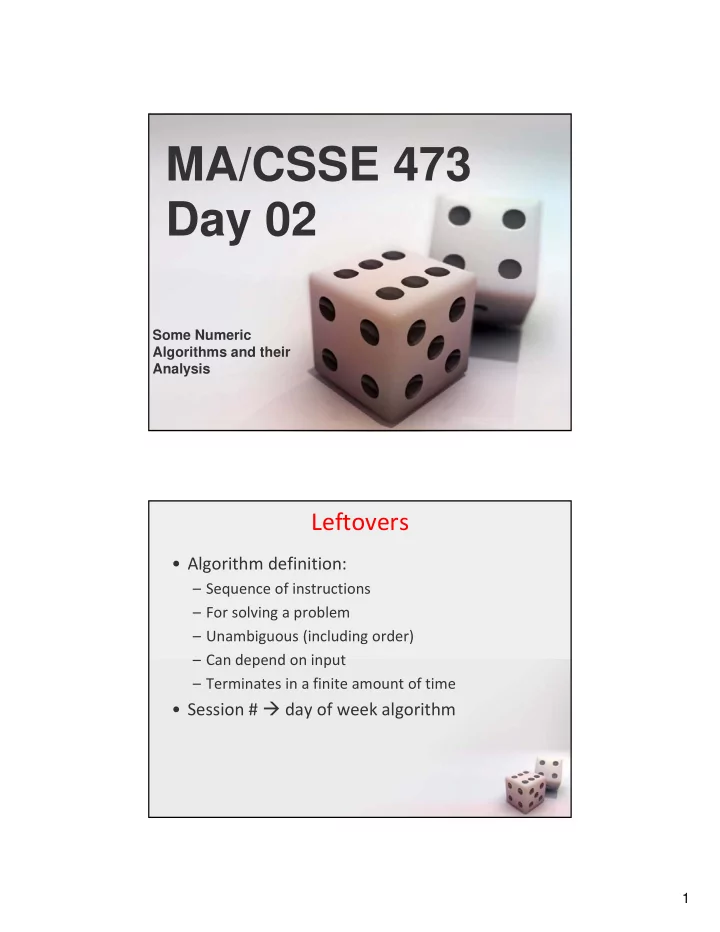

MA/CSSE 473 Day 02 Some Numeric Algorithms and their Analysis Leftovers • Algorithm definition: – Sequence of instructions – For solving a problem – Unambiguous (including order) – Can depend on input – Terminates in a finite amount of time • Session # day of week algorithm 1
Student questions on … • Syllabus? • Course procedures, policies, or resources? • Course materials? • Homework assignments? • Anything else? notation: lg n means log 2 n Also, log n without a specified base will usually mean log 2 n Levitin Algorithm picture 2
Algorithm design Process Interlude • What we become depends on what we read after all of the professors have finished with us. The greatest university of all is a collection of books. ‐ Thomas Carlyle 3
Review: The Master Theorem • The Master Theorem for Divide and Conquer recurrence relations: For details, see Levitin pages 490-491 • Consider the recurrence [483-485] or Weiss T(n) = aT(n/b) +f(n), T(1)=c, section 7.5.3. where f(n) = Ѳ (n k ) and k ≥ 0 , Grimaldi's Theorem 10.1 is a special case of • The solution is the Master Theorem. – Ѳ (n k ) if a < b k Note that page numbers in – Ѳ (n k log n) if a = b k brackets refer to Levitin 2 nd edition – Ѳ (n log b a ) if a > b k We will use this theorem often. You should review its proof soon (Weiss's proof is a bit easier than Levitin's). Arithmetic algorithms • For the next few days: – Reading: mostly review from CSSE 230 and DISCO – In ‐ class: Some review, but mainly arithmetic algorithms • Examples: Fibonacci numbers, addition, multiplication, exponentiation, modular arithmetic, Euclid’s algorithm, extended Euclid. – Lots of problems to do – some over review material – Some over arithmetic algorithms. 4
Fibonacci Numbers • F(0) = 0, F(1) = 1, F(n) = F(n ‐ 1) + F(n ‐ 2) • Sequence: 0, 1, 1, 2, 3, 5, 8, 13, 21, 34, … • Straightforward recursive algorithm: • Correctness is obvious. Why? Analysis of the Recursive Algorithm • What do we count? – For simplicity, we count basic computer operations • Let T(n) be the number of operations required to compute F(n). • T(0) = 1, T(1) = 2, T(n) = T(n ‐ 1) + T(n ‐ 2) + 3 • What can we conclude about the relationship between T(n) and F(n)? • How bad is that? • How long to compute F(200) on an exaflop machine (10^18 operations per second)? – http://slashdot.org/article.pl?sid=08/02/22/040239&from=rss 5
A Polynomial ‐ time algorithm? • • Correctness is obvious because it again directly implements the Fibonacci definition. • Analysis? • Now (if we have enough space) we can quickly compute F(14000) A more efficient algorithm? 0 1 • Let X be the matrix 1 1 F F • Then 1 0 X F F 2 1 F F F F F • also 2 1 0 0 2 n n X X ,..., X F F F F F 3 2 1 n 1 1 • How many additions and multiplications of numbers are needed to compute the product of two 2x2 matrices? • If n = 2 k , how many matrix multiplications does it take to compute X n ? – What if n is not a power of 2? – Implement it with a partner (details on next slide) – Then we will analyze it • But there is a catch! 6
identity_matrix = [[1,0],[0,1]] x = [[0,1],[1,1]] def matrix_multiply(a, b): return [[a[0][0]*b[0][0] + a[0][1]*b[1][0], a[0][0]*b[0][1] + a[0][1]*b[1][1]], [a[1][0]*b[0][0] + a[1][1]*b[1][0], a[1][0]*b[0][1] + a[1][1]*b[1][1]]] def matrix_power(m, n): #efficiently calculate m n result = identity_matrix # Fill in the details return result def fib (n) : return matrix_power(x, n)[0][1] # Test code print ([fib(i) for i in range(11)]) 7
Why so complicated? • Why not just use the formula that you probably proved by induction in CSSE 230 * to calculate F(N)? � � ���� � 1 1 � 5 � 1 � 5 2 2 5 *See Weiss, exercise 7.8 For review, this proof is part of HW1. The catch! • Are addition and multiplication constant ‐ time operations? • We take a closer look at the "basic operations" • Addition first: • At most, how many digits can there be in the sum of three one ‐ digit decimal numbers? • Is the same result true in binary? • Add two 6 ‐ bit positive integers (53+35): Carry: 1 1 1 1 1 1 0 1 0 1 (35) (53) 1 0 0 0 1 1 1 0 1 1 0 0 0 (88) • So adding two k ‐ bit integers is Θ ( ) time. 8
Multiplication of Two k ‐ bit Integers • Example: multiply 13 by 11 1 1 0 1 x 1 0 1 1 1 1 0 1 (1101 times 1) 1 1 0 1 (1101 times 1, shifted once) 0 0 0 0 (1101 times 1, shifted twice) (1101 times 1, shifted thrice) 1 1 0 1 1 0 0 0 1 1 1 1 (binary 143) • There are k rows of 2 k bits to add, so we do an ( k ) operation k times, thus the whole multiplication is ( ) ? • Can we do better? 9
Recommend
More recommend